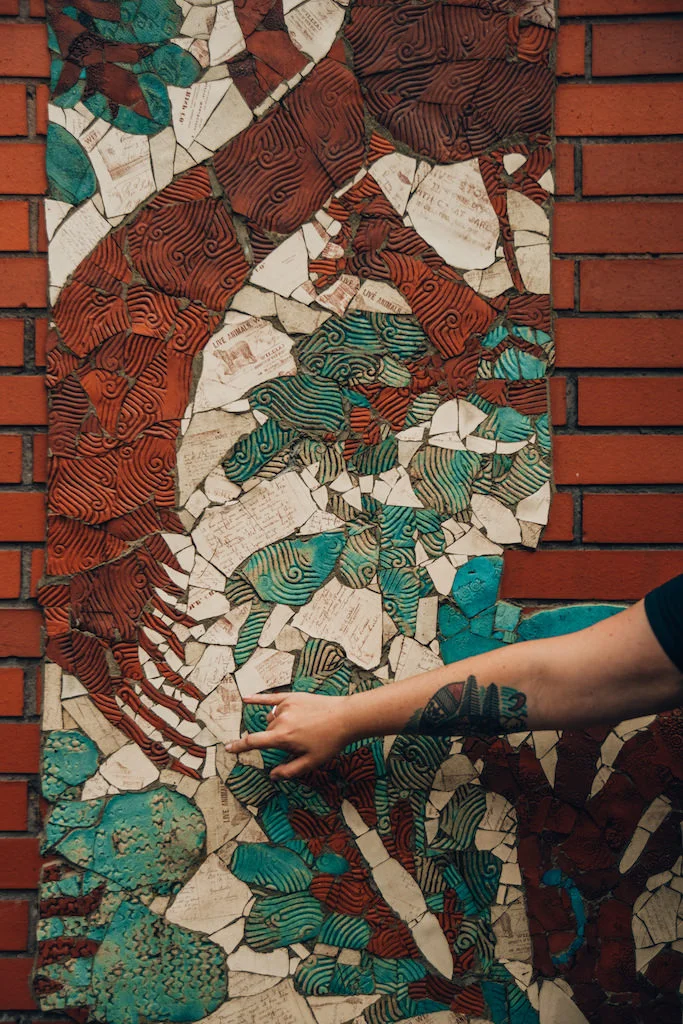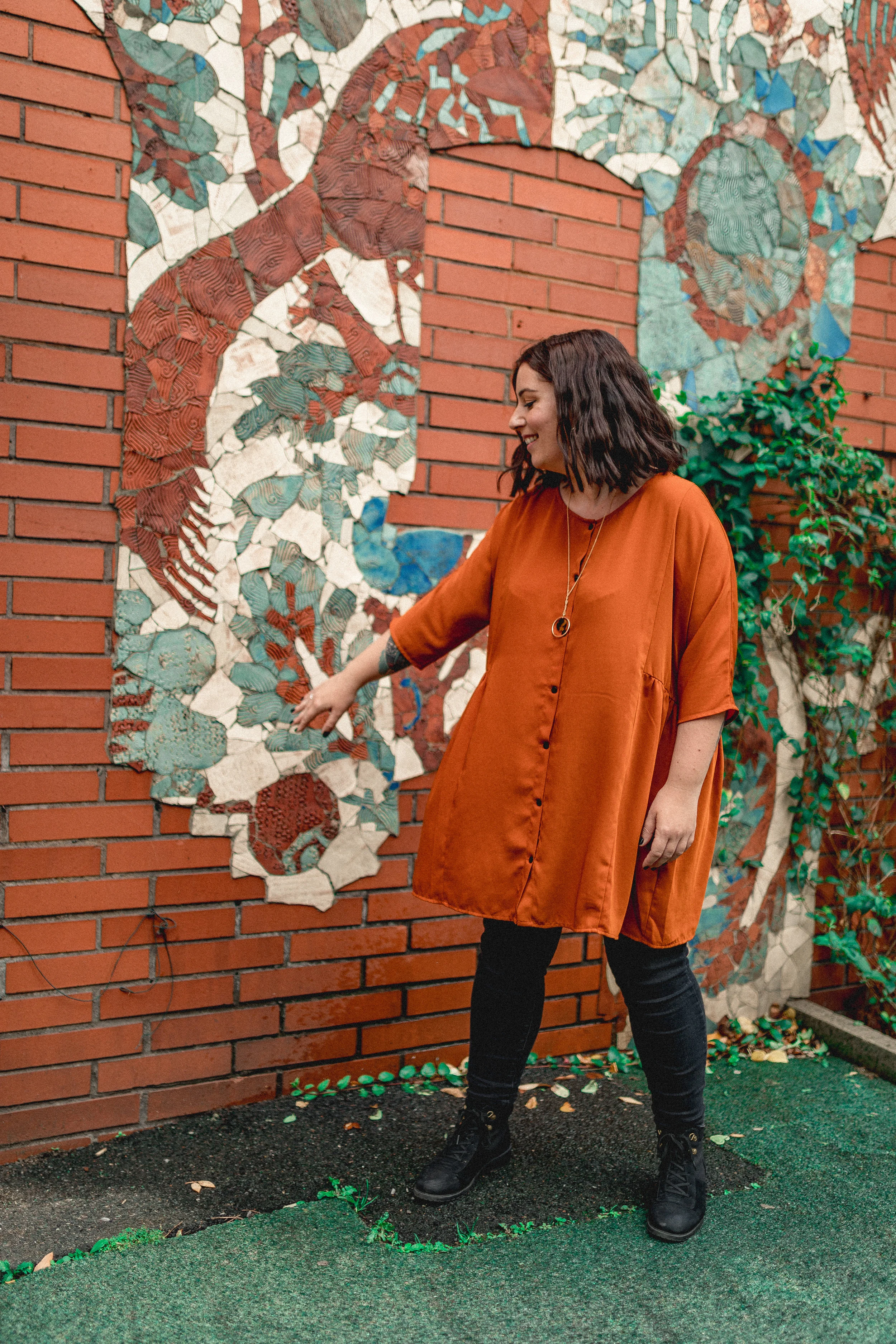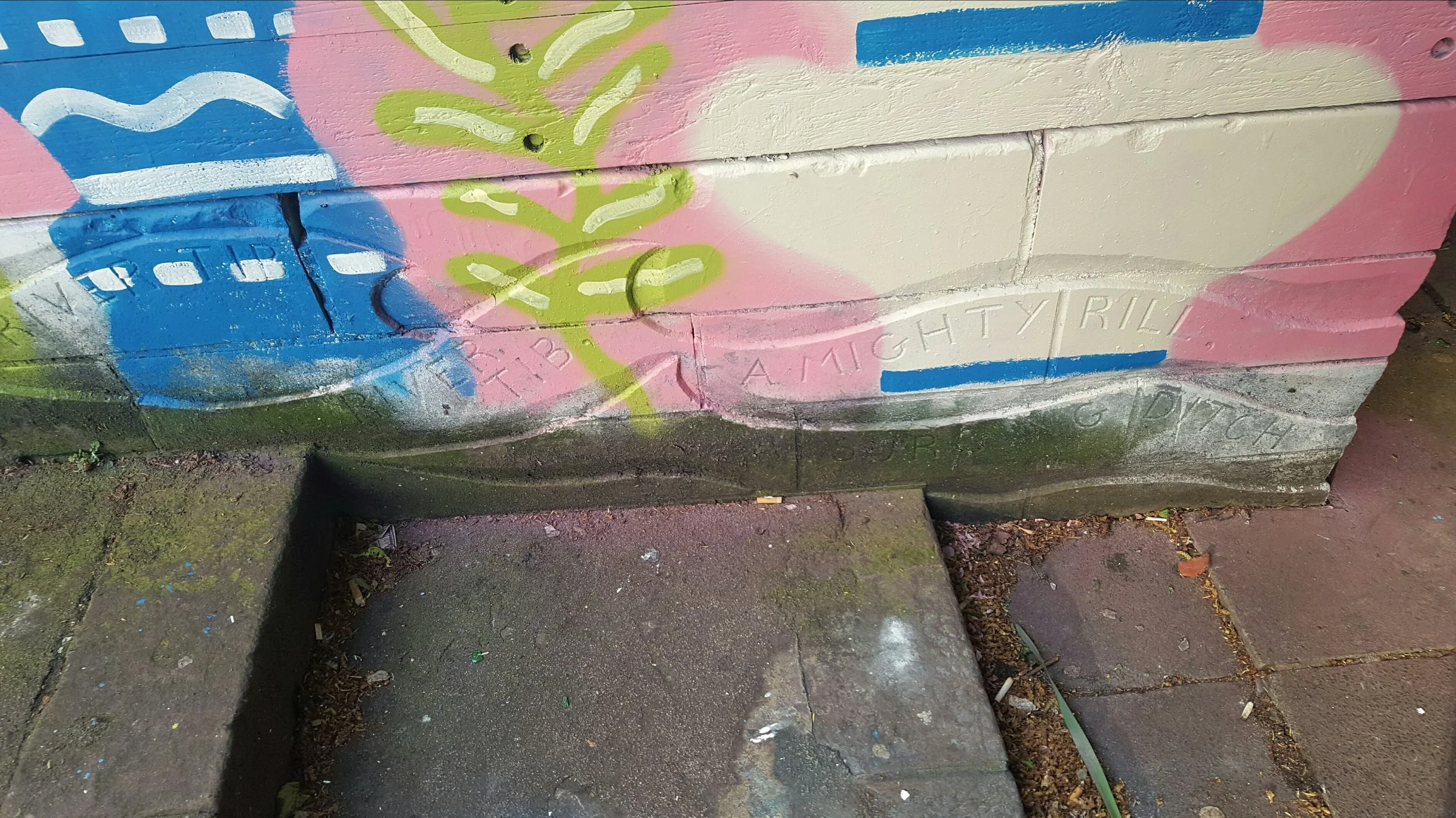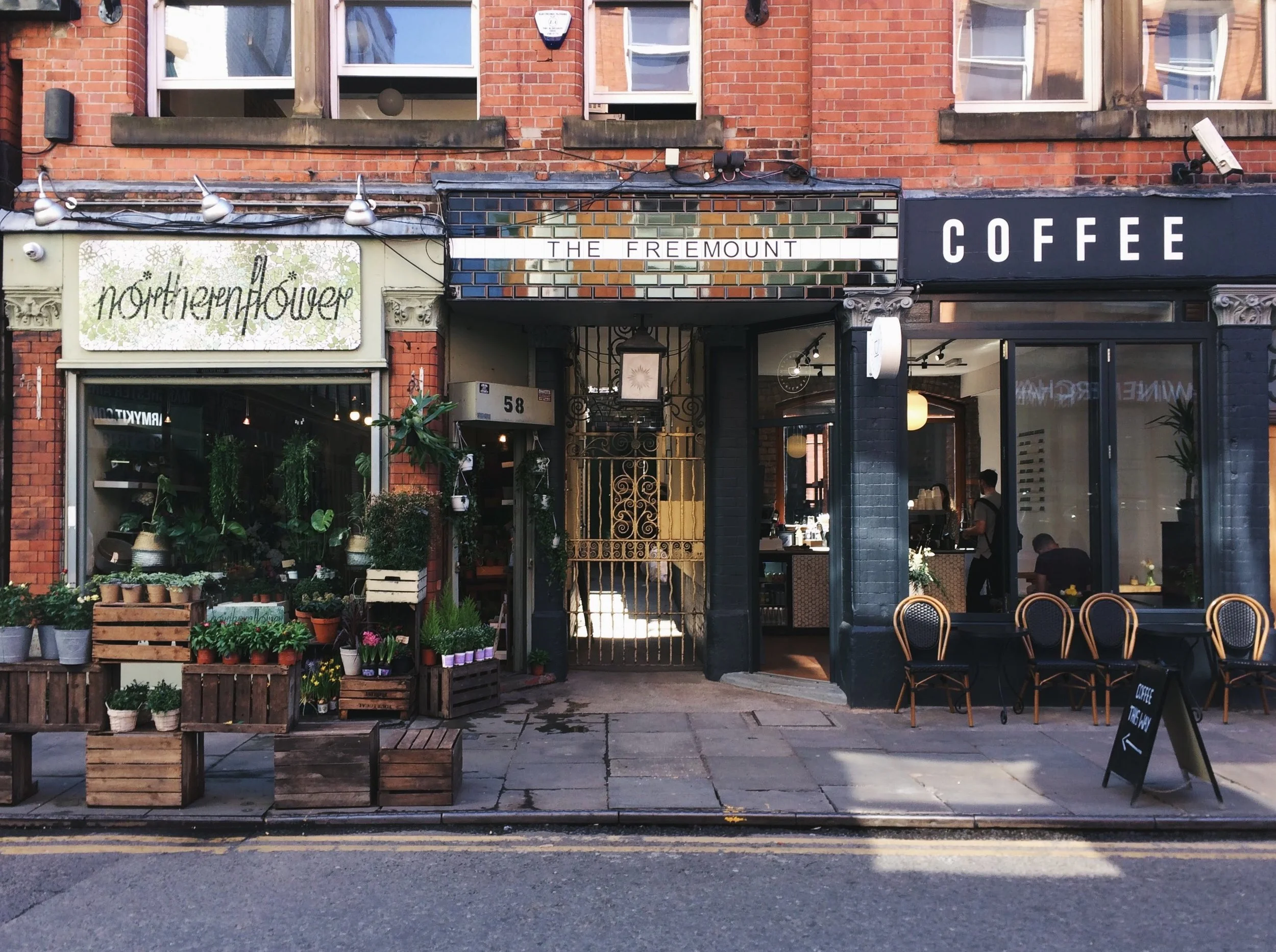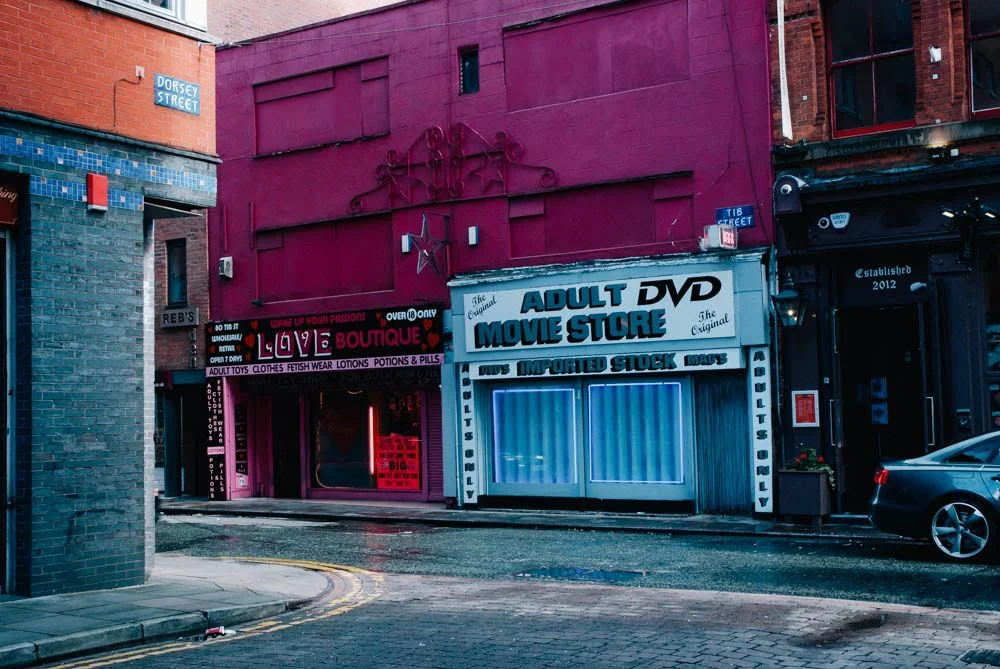THE LIZ SCRINE MURAL ON TIB STREET
WRITTEN BY Hayley Flynn
IMAGES BY Bartek Basista, Arielle Vey, and Hayley Flynn
READING TIME: 7 minutes
When public art tells a story - the history of the Northern Quarter in mural form
You've probably seen Liz's work without registering it, murals and light-boxes tucked away on the periphery of your vision, integrating into the brick of the city so well it becomes a part of it. It took me a while to really fall for her Warp and Weft mural on Tib Street but the level of detail on the piece is fascinating.
Installed in 1998 as part of the Tib Street Trail, a public arts trail dominated by ceramics, the mural is one of the most elaborate pieces of storytelling in the city.
Image by Arielle Vey
The mural, found on Silver Jubilee walk, is meant to be the peeled away, faded wallpaper of Ducks and Potts Mill which formerly occupied the site before it was replaced with the existing council houses championed by councillor Allan Roberts sometime around 1980. At this time the area was nameless and a sad sort of place, coined by Tony Wilson as ‘our fucking Detroit’.
Once a thriving district of markets, pubs, shops and housing, once the Arndale Centre opened in the mid-70s the area was left floundering - in direct competition with the American-style shopping mall which, rather than connect with the shopping district on Oldham Street, turned its back to it instead. Walter Smith’s was the last pet shop on Tib Street (it closed in 2004 - although today Urban Jungle is at the top of the street its doorway and address are actually Swan Street). Walter’s son who took over the business said of this redevelopment:
‘…when we finished the area had really died a death. Everything changed when town was moved and the Arndale was built.'
With Warp and Weft Scrine wanted to give a voice to the past lives of Tib Street - not just to the humans but the animals too. The inspiration for some of her work around the district include storytellers such as Dylan Thomas with Under Milk Wood, and Tom Waits with his song Cemetery Polka, both of which tell stories of ordinary folk.
'I know it's a bit hocus pocus sounding but physical things have an energy to them and that place would have stood there for years and people would have worked there and even though its gone theres a kind of ghost of the energy that remains and that's what its about’.
- Liz Scrine
Image by Bartek Basista
Details within the mural reflect the history of the immediate area - the imprint of oak leaves for Oak Street, which would have once been a green space before the city expanded and it became dominated by the fish and poultry market (now Manchester Craft and Design Centre). The imprint of lace and jute for the weavers in the area, most of the original weavers cottages can be found all over the Northern Quarter and many of these are listed giving the NQ the highest density of listed buildings within Manchester. There’s buttons on the eyes of birds for button makers, and some tiles replicate business signs from the Victorian era. Just before the mural was created Steve Little, a researcher on the project, discovered some old pet shop adverts and letters under the floorboards of a former pet shop on Tib Street and a selection of these, from 1912 and earlier, have been transferred onto the pale tiles within the mural itself. You can see adverts for live tigers, and read a letter of complaint about a mail order macaw who arrived with only one eye and a broken wing.
Tidal waves etched into the tiles denote the River Tib which flows beneath Tib Street and is completely culverted. This river is, to those who study rivers (limonologists), a bone of contention - many believing it should never have been elevated to river status. Geoffrey Ashworth in his book The Lost Rivers of Manchester says: ‘How the Tib, the smallest, most insignificant of waterways was ever elevated to a River no-one will ever know’.
Further along Tib Street, on an electricity substation wall someone has carved a poem into the brick work: ‘River Tib, River Tib, a mighty rill, a surging ditch’, declaring it a mere stream, a muddy puddle. Some people even think that the name, rather than being Celtic, is a diminutive of the River Tiber given to the Tib when Romans occupied the city.
Image c/o Manchester Libraries, Tib Street, 1959
Bare brick within the mural indicates the windows of the mill and these windows had quite deep windowsills; as such they were a popular place to set down bird cages during the street’s time as ‘Pet Paradise’, and whilst most of the animals celebrated in the Tib Street Trail are also birds, according to a 1922 article in The Guardian, the dog was the main draw of Pet Paradise…
Image c/o Manchester Libraries, dogs on the corner of Tib Street in 1959
River Tib poem on electricity substation
'Larks and linnets, goldfinches and thrushes, send now and then down the street their harrowing songs. Birds that have taken more kindly to captivity are here too: parrots, streaking the drab exteriors of the shops with green and flame: grey cockatoos sulfur-crested, with judicial noses and eyes of hard wisdom: and canaries without number. You could at one time buy a lark for sixpence. The struggling brown body was handed to you in a paper bag, as if you were buying chipped potatoes […] I have seen a marmoset on Tib Street and I have handled 'pups' there which I am prepared to swear were wolf cubs. I have seen a donkey on sale there, and have at any rate dreamed that the ceiling of one shop had been removed to permit the more convenient installation of a giraffe. But Tib Street's notable animal is the dog. Dogs are there from the size of pups that should be with their mothers to wistful fellows too old to change their homes. They are in baskets and cages, they are tied to the legs of tables, and they are tied leg on strings at the pavement's edge by doubtful looking vendors.' - Oct 16 1922, The Guardian, Round about Tib Street.
Scrine’s piece was never meant to be quite so exposed, ivy was meant to grow over much of it and you can see the iron rings for it to cling and climb over. Scrine’s intention was to present the piece through this wall of ivy where you would only ever spy glances of the mural through the canopy, as if discovering a real hidden piece of the past, but she was driven to do this by acknowledging what residents of the city want most of all - greenery: 'What local people actually want more than art is greenery and green spaces but the council don't want to provide green spaces because they're really expensive in terms of maintenance, so I tried to plant something myself but I'm not a gardener and it was just a horrible failure, but it's taken a little bit, hasn't it?’
And it has, in the last couple of months a creeper, not ivy, has started to flourish and someone has trained it up those original hooks, so maybe now, 21 years later, we might finally see the mural as intended all those years ago.
Tib Street today
Another snippet of life on Tib Street from that same Guardian article peers into the steamy windows of its cafes, where now you can pick up doughnuts and flat whites, 100 years ago tripe and peas were the order of the day.
'But we have in Manchester a few places of colour and racy flavour […] Tib Street, as characterful a street as one may hope to see […] It is shut in by offices and warehouses. Great shopping thoroughfares hedge it about. Its eastern end is closed by a drab church spire. Unhopeful surroundings, but what a street! The rough life of the neighbouring market overflows into it. Barrows piled high with magenta plums and scarlet tomatoes stand at the pavement's edge. Shrill voices cry incredible prices. There is a score of little shops perspiring with the steam of of frying sausages and faggots, and with the exudation from mountains of coagulated green peas. Little flat cakes, too, gargantuan steak and kidney pies, and tripe in bleached perfection. It is hard to see through the windows because of the steam on them, but one dimly makes out a sawdust strewn floor and tables, between wooden partitions where carters, with faces like bronzy moon, are engaged in heroic acts of delugition’


